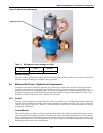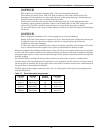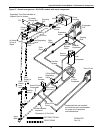
Glycol/GLYCOOL-Cooled Models—Self-Contained Compressor
46
NOTICE
Risk of corrosion from water impurities. Can cause equipment damage.
The quality of water used for dilution must be considered because water may contain
corrosive elements which reduce the effectiveness of the inhibited formulation. Water that is
classified as soft (low in chloride and sulfate ion content less than 100 parts per million each)
should be used.
5.5.3 Filling the System
Installation of hose bibs at the lowest point of the system is recommended. When filling a glycol sys-
tem keep air to a minimum. Air in glycol turns to foam and is difficult and time-consuming to remove.
(Anti-foam additives are available and may be considered.) Open all operating systems to the loop.
With the top vent(s) open, fill the system from the bottom of the loop. This will allow the glycol to
push the air out of the top of the system, minimizing trapped air. Fill to approximately 80% of calcu-
lated capacity. Fill slowly from this point, checking fluid levels until full.
Table 16 Ethylene glycol concentrations
% Glycol by Volume 0 * 10 20 30 40 50
Freezing Point °F (°C) 32 (0) 25 (-3.9) 16 (-8.9) 5 (-15.0) -10 (-23.3) -32 (-35.5)
Apparent Specific Gravity
@ 50°F (10°C)
1 1.014 1.028 1.042 1.057 1.071
* A minimal amount of glycol should be considered for inhibitive coil protection.
NOTE
For glycol solution preparation and periodic testing, follow manufacturer's recommendations.
Do not mix products of different manufacturers.


















